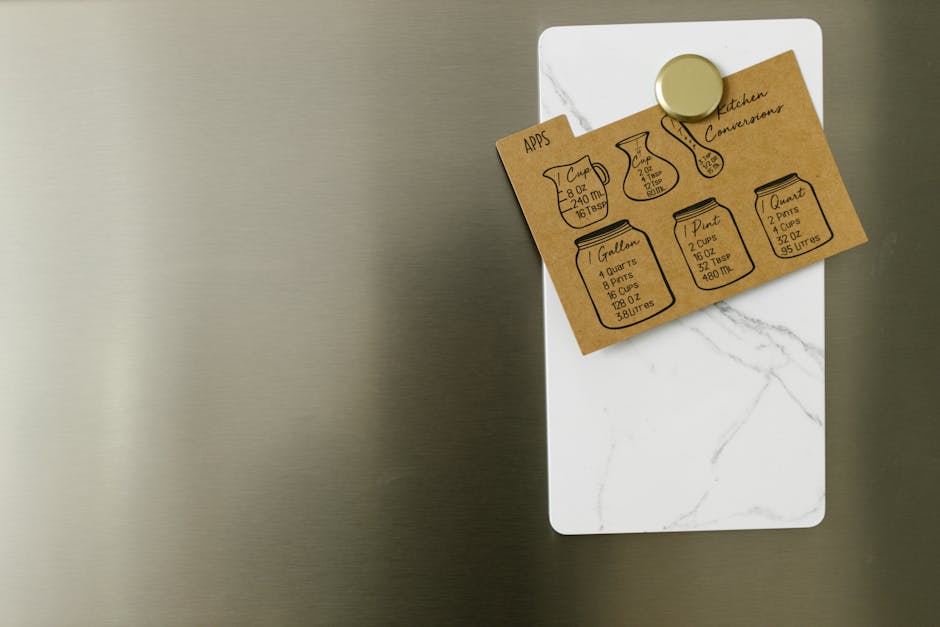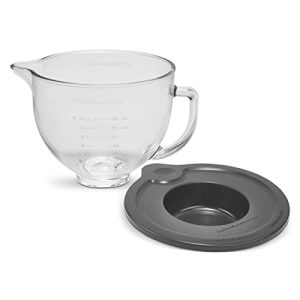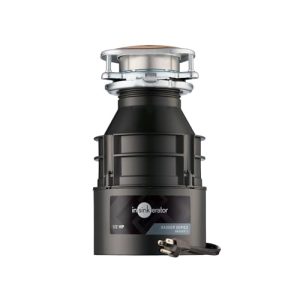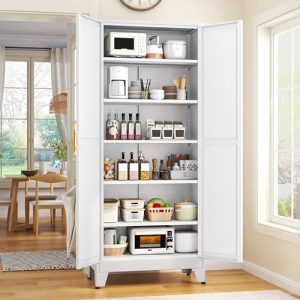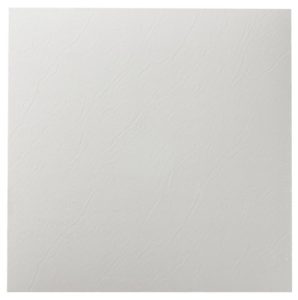Are you shopping for a new kitchen refrigerator and wondering how much space you actually need? Knowing how many cubic feet a standard kitchen refrigerator has can make all the difference in choosing the perfect fit for your home.
You want enough room to store your groceries without overcrowding your kitchen. You’ll discover the typical size range of refrigerators and how to pick the right one for your lifestyle. Keep reading to make a smart choice that keeps your food fresh and your kitchen organized.
Kitchen Refrigerator Sizes
Kitchen refrigerator sizes vary widely to fit different homes and needs. Choosing the right size helps save space and keeps food fresh. Understanding these sizes makes shopping easier and smarter.
Common Capacity Ranges
Most kitchen refrigerators range from 10 to 30 cubic feet. Small models start around 10-14 cubic feet. Medium sizes usually fall between 15-20 cubic feet. Large refrigerators offer 20-30 cubic feet or more.
Typical families use refrigerators around 18-22 cubic feet. Larger homes or those who buy in bulk prefer bigger sizes. Small apartments often need compact models under 15 cubic feet.
Compact Vs Full-size Models
Compact refrigerators fit small spaces and hold less food. They usually measure below 15 cubic feet. Ideal for studios, dorm rooms, or offices.
Full-size models offer more storage and features. They start at about 18 cubic feet and can exceed 30 cubic feet. Best for families and frequent cooks.
- Compact models:smaller, lighter, less expensive
- Full-size models:larger, more capacity, more features
Measuring Cubic Feet
Understanding how to measure the cubic feet of your kitchen refrigerator can help you choose the right size for your needs. Cubic feet measure the actual storage space inside the fridge, giving you a clear idea of how much food you can store. Let’s break down how you can calculate this and what dimensions really matter.
Calculating Interior Space
To find the cubic feet of your refrigerator, you need to measure the interior length, width, and height in feet. Multiply these three numbers together:
- Cubic Feet = Length × Width × Height
For example, if the interior is 2 feet deep, 3 feet wide, and 5 feet tall, the calculation would be 2 × 3 × 5 = 30 cubic feet.
Keep in mind, not all spaces inside the fridge are usable due to shelves and compartments. So, the actual storage might be slightly less.
Dimensions To Consider
Measuring just the overall size of the fridge doesn’t tell the whole story. You should focus on the usable interior space, which can vary due to shelf layout and door bins.
Also, check these dimensions:
- Depth:How far back the storage area goes.
- Width:The horizontal space inside.
- Height:The vertical space, including freezer and fridge compartments.
Ask yourself: Does the fridge design maximize space, or does it have bulky components that reduce storage? Knowing this will help you pick a model that fits your lifestyle perfectly.
Factors Influencing Size Choice
Choosing the right size for your kitchen refrigerator is more than just a matter of taste; it’s about fitting your lifestyle and your kitchen space like a glove. The size of a standard kitchen refrigerator is typically between 18 to 26 cubic feet, but the best choice can vary based on several factors. Understanding these factors can help you make a decision that aligns perfectly with your needs and enhances your kitchen experience.
Household Needs
Think about how many people live in your household and how often you cook at home. A family of four, who regularly cooks and eats together, might require a larger refrigerator to store more groceries and leftovers. In contrast, a single person or a couple may find a smaller model more efficient and easier to manage.
Consider your shopping habits as well. Do you buy groceries in bulk or prefer fresh produce purchased more frequently? Bulk buyers often benefit from the extra space, while those who shop for fresh items might not need as much storage. Reflect on your personal habits and preferences to determine what size will serve you best.
Kitchen Space Limitations
Your kitchen layout significantly impacts the size of refrigerator you can accommodate. Measure the space where you plan to place the fridge, including width, height, and depth. Remember to leave some room for door clearance and ventilation, ensuring that your new appliance functions efficiently.
It’s also crucial to consider the flow of your kitchen. Will a larger refrigerator obstruct pathways or make it difficult to access other appliances? A well-fitting refrigerator should complement your kitchen’s design, not hinder its functionality. Take a moment to visualize how the appliance will integrate into your existing space before making a decision.
Choosing the right refrigerator size involves balancing your household needs and kitchen space limitations. Have you considered all aspects that might affect your choice? Making an informed decision can lead to a more organized, functional, and enjoyable kitchen environment.
Types Of Kitchen Refrigerators
Kitchen refrigerators come in different styles to suit various needs. Each type has a unique design and storage capacity. Understanding these types helps choose the right size and cubic feet for your kitchen.
Top Freezer
Top freezer refrigerators have the freezer compartment above the fridge. This design is common and usually more affordable. They often range from 14 to 22 cubic feet. Their simple layout offers easy access to both fridge and freezer.
Bottom Freezer
Bottom freezer models place the freezer below the fridge. This setup keeps fresh food at eye level. These refrigerators usually measure between 18 and 25 cubic feet. They save bending down for fresh items, making daily use easier.
Side-by-side
Side-by-side refrigerators split the fridge and freezer vertically. The fridge is on one side, freezer on the other. Sizes often range from 20 to 28 cubic feet. Narrow doors fit well in tight spaces, ideal for smaller kitchens.
French Door
French door refrigerators have two doors for the fridge section. The freezer is located below, usually as a drawer. These models offer spacious storage, often 20 to 30 cubic feet. They provide wide shelves and flexible organization options.
Energy Efficiency And Size
Energy efficiency and size play a key role in choosing a kitchen refrigerator. A larger fridge uses more power but stores more food. Finding the right balance saves energy and fits your household needs. Understanding how capacity affects energy use helps make smart choices.
Impact Of Capacity On Energy Use
Refrigerator size affects electricity consumption directly. Bigger models need more energy to keep food cold. A standard kitchen refrigerator usually ranges from 18 to 25 cubic feet. The higher the cubic feet, the more power it requires.
Choosing a fridge slightly larger than needed wastes energy. Smaller models often run more efficiently. Proper size reduces running costs and lowers your electric bill.
Energy Star Ratings
Energy Star labels identify refrigerators that use less electricity. These fridges meet strict energy efficiency guidelines. They help cut down power use without sacrificing performance.
Look for Energy Star when shopping for a fridge. It ensures the appliance saves energy over its lifetime. This rating supports environmental protection and reduces utility expenses.
Tips For Selecting The Right Size
Choosing the right size for a kitchen refrigerator is key for comfort and efficiency. Too small, and you run out of space quickly. Too large, and you waste energy and money. Knowing how to pick the correct size saves hassle and fits your lifestyle.
Focus on your storage habits and future needs. This helps avoid frequent shopping trips or food spoilage. Think about the space available in your kitchen too. These tips guide you to the ideal cubic feet for your fridge.
Assessing Food Storage Habits
Start by checking how much food you buy weekly. Note if you store fresh fruits, vegetables, or frozen items more. Consider your meal style: quick snacks or full home-cooked meals? These habits affect fridge size needs.
List types of food you keep often. Bulk buyers need bigger space. Small households or singles might need less. Track how often you shop to adjust size accordingly.
Planning For Future Needs
Think about family growth or lifestyle changes soon. Expecting guests or larger meals? Plan extra space for those times. Upgrading kitchen appliances might also need a different fridge size.
Consider energy efficiency for bigger models. A larger fridge uses more power. Balance size with your energy budget. Adjust size to match your future plans.
Frequently Asked Questions
What Is The Average Cubic Feet Of A Kitchen Refrigerator?
A standard kitchen refrigerator typically ranges from 18 to 26 cubic feet. This size suits most households and offers ample storage for daily needs. Larger models can exceed 30 cubic feet, ideal for bigger families or frequent shoppers.
How Do Cubic Feet Affect Refrigerator Capacity?
Cubic feet measure the internal storage volume of a refrigerator. More cubic feet mean more space for food and beverages. Choosing the right size depends on your household size and storage requirements. Proper capacity ensures efficient organization and reduces food waste.
Are Larger Refrigerators More Energy Efficient?
Not necessarily. Energy efficiency depends on the model, not just size. Larger refrigerators may consume more power if not energy-rated. Look for ENERGY STAR-certified models to balance size and energy savings, regardless of cubic feet.
Can Kitchen Space Limit Refrigerator Cubic Feet Size?
Yes, kitchen layout and available space restrict refrigerator size. Measure your kitchen area before purchasing to ensure a proper fit. Compact models with smaller cubic feet suit tighter spaces without compromising functionality.
Conclusion
A standard kitchen refrigerator usually holds between 18 and 25 cubic feet. This size fits most family needs well. It offers enough space for fresh and frozen foods. Choosing the right size helps keep food fresh and organized. Small kitchens may need a smaller fridge.
Larger families might want a bigger one. Knowing the cubic feet helps you pick the best fit. It also helps with planning your kitchen space. A good fridge size supports everyday cooking and storage. Simple and clear choices make life easier.

Sophie Hartwell is the founder of KitchenQuik.com, where she shares kitchen tips, smart cooking hacks, and the best product picks to make everyday cooking easier and more enjoyable.
